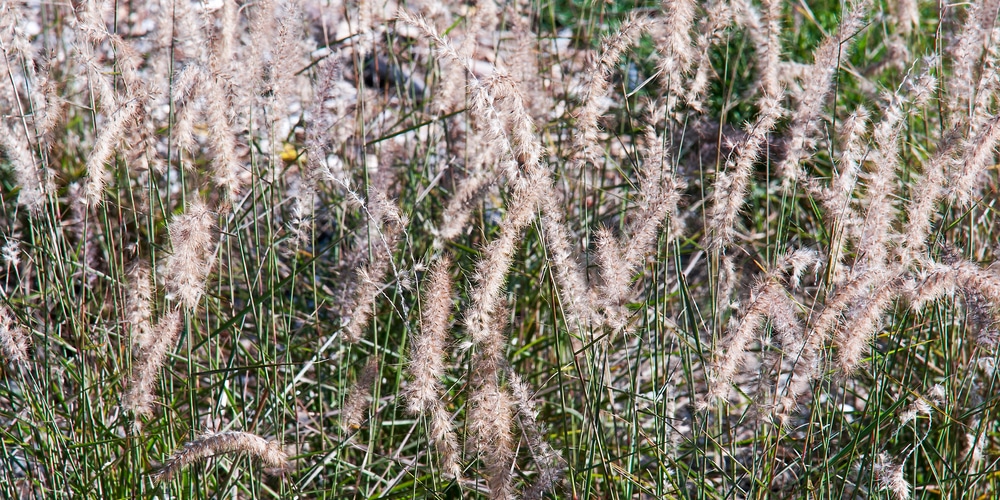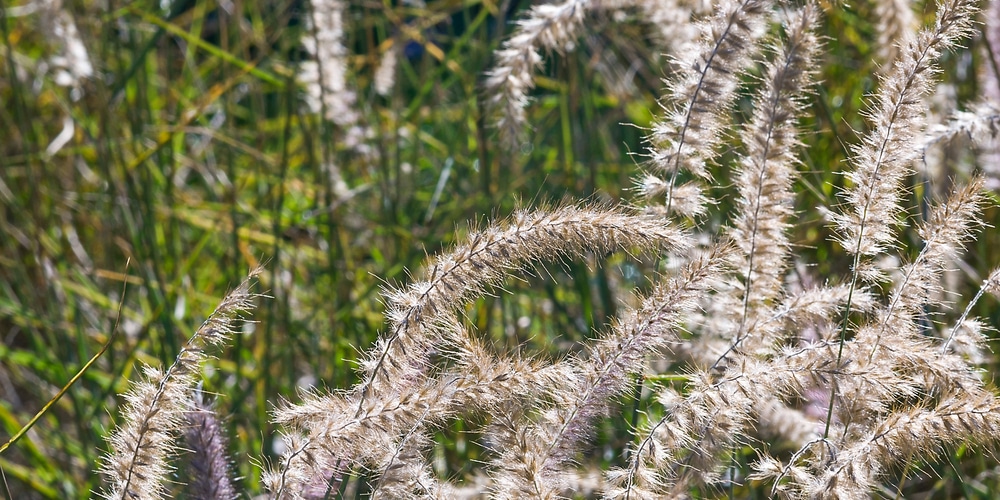The Karley Rose Fountain grass, commonly known as oriental fountain grass, is a stunning ornamental grass that’s perfect for adding height and drama to your garden beds and borders.
Despite its name, oriental fountain grass is actually a perennial plant native to Asia and parts of the Mediterranean.
Among gardeners, it’s prized for its tall, arching leaves and showy plumes of pinkish-purple flowers that bloom in mid-summer and early fall.
If you’re thinking of adding oriental fountain grass to your garden, here’s what you need to know about Karley Rose care, including tips on how to plant, grow, and prune this striking grass.

| Botanical Name | Pennisetum Orientale ‘Karley Rose’ |
| Common Name | Oriental Fountain Grass |
| Plant Type | Perennial |
| Flower Color | Pink-red that fades to a soft beige |
| Size When Mature | 24-36 inches |
| Bloom Time | Mid-summer to early fall |
| Sun Requirements | Full sun, tolerates some shade |
| USDA Hardiness Zones | 5-9 |
| Soil PH Range | 5.8-6.2 |
| Soil Type | Acidic to neutral, moist, well-draining soil |
| Water Needs | Low to Medium |
| Native Area | Asia |
What You Need to Know About Karley Rose Fountain Grass
Karley Rose fountain grass (Pennisetum Orientale ‘Karley Rose’) is a clump-forming perennial grass that typically grows 2-3 feet tall and wide. It’s noted for its arching, linear leaves that are green in summer and turn a beautiful burgundy-bronze color in fall.
From mid-summer to early fall, the grass produces showy plumes of rose-pink flowers that rise above the foliage on slender stems. Its flowers last well as cut flowers, making it a good choice for dried arrangements.
Its beautiful foliage sways with the slightest breeze, adding movement and interest to the garden. When planted en masse, oriental fountain grass makes a dramatic impact on the landscape. It’s also lovely when grown as a specimen or accent plant in mixed borders.
Despite its delicate and elegant appearance, oriental fountain grass is actually a tough and adaptable plant that’s easy to grow in almost any sunny spot in your yard. It’s also relatively drought-tolerant, making it a good choice for hot, dry areas of your landscape.
How to Care for Karley Rose Fountain Grass
Here’s everything you need to know about growing and caring for a thriving Karley Rose Fountain grass.
Light
The beautiful Karley Rose Fountain grass is a stunning addition to any garden. But before you add this show-stopper to your landscape, it’s important to know a little bit about its light requirements. This variety of grass does best in full sun, but it can tolerate some shade.
In fact, in areas with hot summers, a little bit of afternoon shade can actually be beneficial. Too much sun can cause the leaves to scorch and turn brown. If you live in an area with hot summers, try planting Karley Rose Fountain grass in an area that gets some afternoon shade.
Sunlight exposure for at least six hours a day is ideal.
Water and Soil Needs
One of the secrets behind the plant’s graceful leaves and delicate flowers is its need for plenty of water. Karley Rose Fountain grass is a moisture-loving plant that does best in moist, well-drained soil.
With its deep roots and low water needs, this fountain grass is an excellent choice for gardens in dry climates. Fountain grass should be watered regularly but allowed to dry out somewhat between waterings. A good rule of thumb is to water the plant deeply once a week.
This tough plant is also adaptable to various soils, from sandy to clay, with acidic to neutral pH levels between 5.8-6.2.
Temperature Requirements
Adding some visual interest to your garden beds and borders. Karley Rose Fountain grass is not only drought-tolerant but also heat-tolerant, making it a good choice for hot, dry areas of your landscape. It’s winter hardy in USDA zones 5-9.
Fertilizer
The best fertilizer to use on a Karley Rose Fountain grass is a slow-release fertilizer, preferably one that is organic granular. This type of fertilizer will provide a steady supply of nutrients to the plant over a period of time without burning the roots.
Slow-release fertilizer should be applied in early spring before new growth begins. Apply the fertilizer at the rate recommended on the package label.
Common Diseases
Karley Rose Fountain grass is a tough, disease-resistant plant. However, there are a few diseases that can affect the plant, including rust and leaf spots. These diseases are usually not fatal to the plant and can be controlled with fungicide sprays.
Additionally, it’s important to space the plants properly to promote good air circulation and prevent disease.
Pests are not typically a problem for this variety of grass, but aphids, mites, and caterpillars can occasionally be a problem. These pests can be controlled with insecticidal sprays.
Karley Rose Fountain Grass Propagation
The best way to propagate fountain grass is by division, which can be done in spring or fall. To divide the grass, start by digging up the entire plant. Using a sharp knife, carefully divide the root ball into smaller sections, making sure that each section has a good root system.
Once you’ve divided the plant, replant each section in a prepared bed of well-drained soil. With proper care, your new fountain grass plants will take root and flourish in no time!
Karley rose fountain grass: Final Thoughts
With the plant’s long, slender green leaves, paired with delicate pink flowers, this plant isn’t all about beauty! It’s a show-stopper that even new gardeners can quickly grow with a little bit of care.
With the right light and water conditions, this plant will thrive in your landscape for years to come.
So, if you’re looking for a beautiful and low-maintenance plant, Karley Rose Fountain grass is a perfect choice!
Related Article: Can You Overwinter Purple Fountain Grass?

